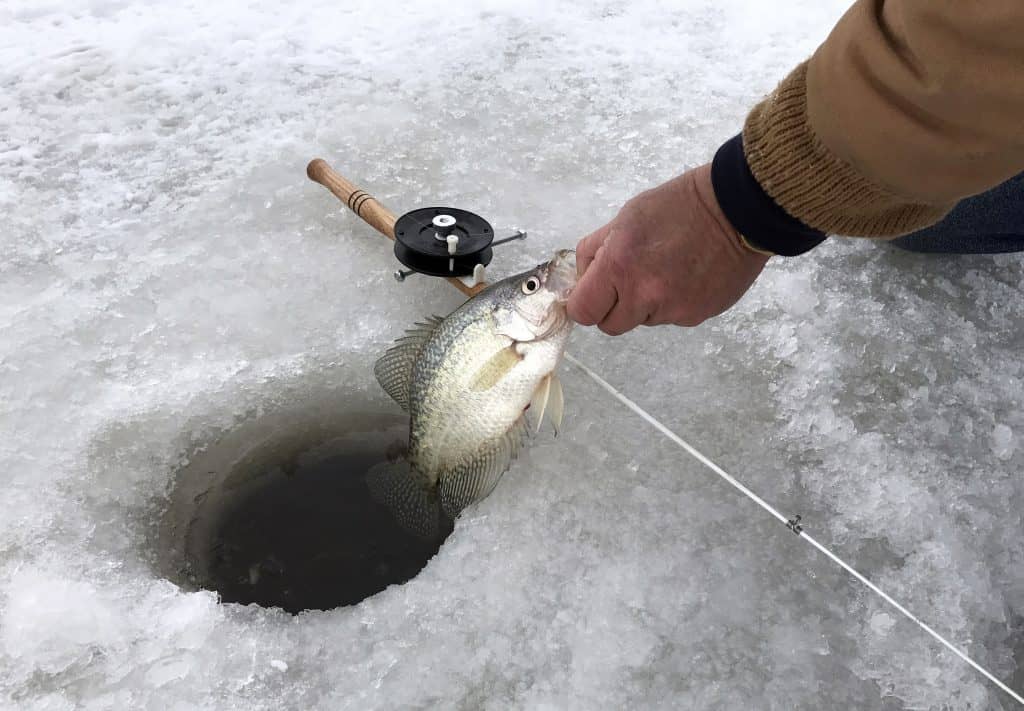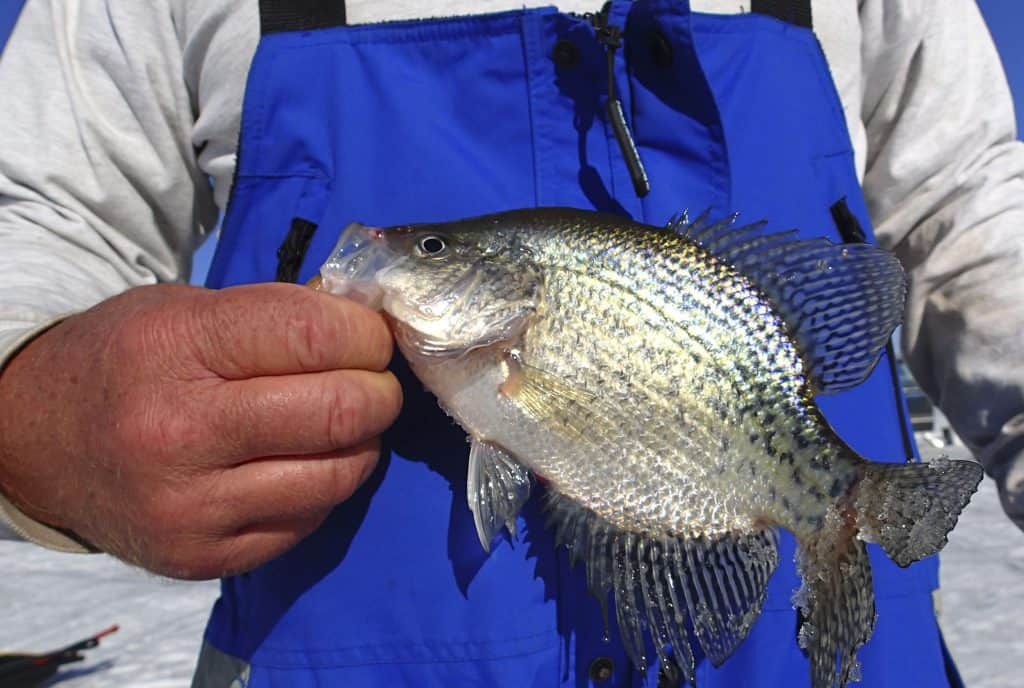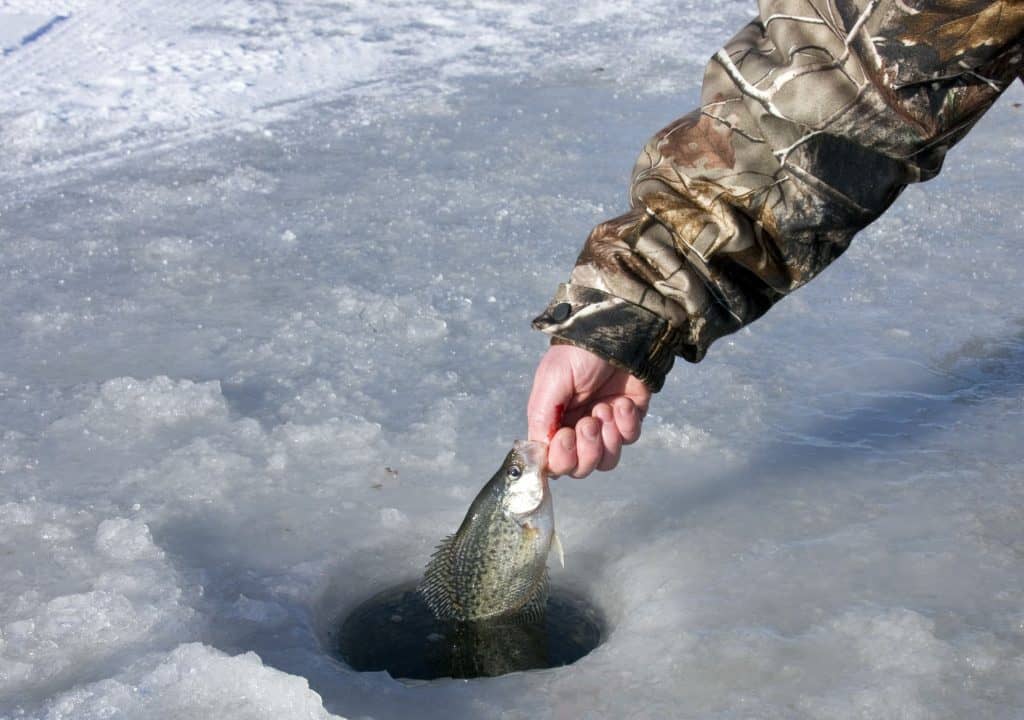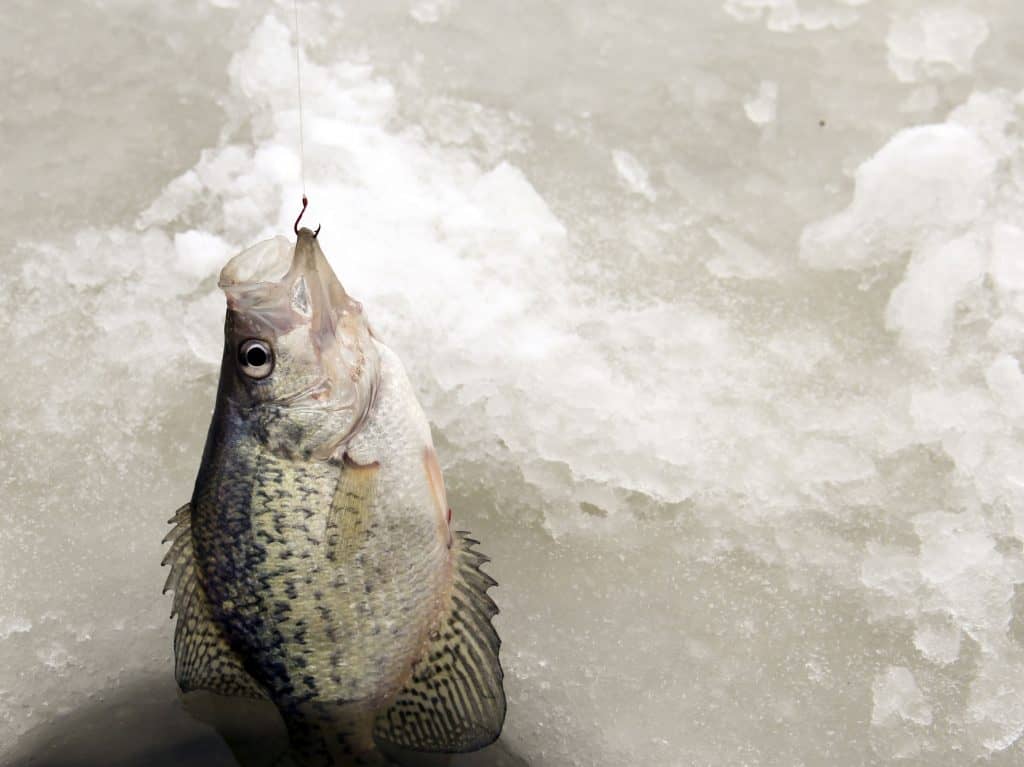
Crappie are a great and popular fish during the ice fishing season. I have found some at nearly every place I try. They are a great looking fish and rewarding to pull out of the water.
Because of their popularity, I thought I would share some tips and things that I have found work. Ask around and see what other tips people give you. People have been doing this for a while so there is bound to be some great information out there. Enjoy these 22 tips for crappie that are not crappy!
1. Keep the Light Out
Crappie do not like light. They feed mostly when it is dark out so if you want to catch them when there is light out. You will have to try a few different things. They are a finicky fish.
Your success at catching crappie during the day will be largely affected how well you diffuse the light shining through the hole. One way that I do that is throwing little ice shards in the hole to disperse the light. Do not throw any lights down into the water. It will scare the crappie away. Another way to get rid of light is to use an ice shanty and keep the lights dim. I think by and large that is the best choice for avoiding light.
Of course, this whole issue could be avoided and would be easier if everybody went ice fishing anywhere from 6 pm to 6 am but that is easier said than done. I can’t blame anybody either. I would not want to be outside late at night on the ice. That sounds dangerous and cold.
2. Drill Lots of Holes
Crappie and bass run around a lot, especially at night. They tend to be more still during the morning hours. During the summer this would not be a problem as much but when you can’t see the fish and you have to guess, it becomes much more frustrating.
This is why I suggest making multiple holes. More holes in a certain radius from your base camp will allow for more chances to catch the crappie running around. You can either have lots of holes to fish from with your buddies or set up a bunch of tip-ups.
There are various ways to do this. You could just spread them out randomly and not have a biased direction or area.
I prefer to have a straightforward approach. Literally, straightforward. What I do is put my extra holes in a line straight in front of my line of sight. I put tip-ups in the water and watch to see if anything catches.
Because they are all lined up and in my direct vision, I know when one gets tripped. When I look up I can know right away and I do not need to move to see how my tip-ups are doing.
3. Search for Vegetation
Vegetation is crucial to the survival of fish during the winter. Because of that, vegetation is a good indicator of where fish are. What does vegetation like underwater grass provide?
- Food for wildlife
- Habitat
- Add oxygen to the water
- Trap sediment
- Refuge for marine life
- Reduce erosion
- Absorb pollution
Small invertebrates surround the vegetation and the fish feed on them. So you can imagine that the fish in the water want to live near the seagrass. Finding aquatic plants, especially during the beginning of the season, can really increase your odds of finding fish.
Your life will be made much easier if you have an underwater camera. It will be pretty difficult to find this stuff without a camera to reach far down in the water.
Not only can vegetation tell you where to find a good ice fishing spot, but it also tells you where not to fish. Sometimes when you cut through the ice, you will find dead plants that float to the top and you will smell the decomposing plant. This is a good place to avoid. If the plants are dead then you will not find fish there.
4. Crappie Will Change Location Depending on Time of Winter
Crappie are interesting fish. They are very finicky. I think I have already said that before but I really cannot stress that. You have to adapt to them, unfortunately.
As temperatures change in the water, they move to different levels of the water column. Understanding their patterns is extremely helpful for finding these fish.

5. Fish at the Bottom During the Beginning of Winter
At the beginning of the season, the water is warmer at the bottom of the lake. The temperature at the top is around 32° F and the bottom is 39° F. The bottom is also where the food is. The oxygen and other nutrients for the small invertebrates exist among the plants and the fish eat the small organisms. So naturally, crappie are going to be near the bottom of the lake.
I would say keep your line at about 2 or 3 feet off of the bottom of the lake. The fish will have to swim upward and latch on. Crappie like to catch a meal this way.
6. Later in the Season, Fish are Suspended in the Water
The fish will eat up all of the nutrients down at the bottom by the late season. They then move closer to the top where other food is. This does not mean that they will all be at the top of the lake. They will however more than likely be suspended throughout the water column.
This is where a camera or ice fishing flasher would really come in handy. They can help you see where the fish are. I think the sonar/flasher device shines in this circumstance. It shows you where the fish are and it shows you where your lure is at. You can watch your line go down and see the fish come up to get it. At that point, you really do not need to “find” the fish. You only need to see where your line is in relation to the fish.
If you are not familiar with the ice fishing flashers, I have provided a video for you that explains how they work.
7. Fish Near Dead, Smaller Fish
Now I said that dead plants mean that no fish are nearby, but what about dead smaller fish? Sometimes when you are on clear ice, you can see some tiny fishes that have floated to the top of the lake for their icy end. This could mean that bigger fish (hopefully crappie) are feeding down below. What a better time to catch fish then feeding time, am I right?
This is one of the perks of ice fishing on clear ice. Use it to your advantage! If you live in an area with clear ice lakes, take your auger and drill holes near the dead fish. Send down a line and see what you can get. Chances are the fish are still feeding down there and just might take the bait.
8. Check Near the Bay Mouth for Crappie
I think that this is such an interesting way of looking at ice fishing. Let’s do a little geography. A bay, according to the National Geographic Society is “a body of water partially surrounded by land.” A bay also is an inlet that extends from a larger body of water. A bay is more shallow than the bigger portion it is connected to. Because of this, bays will freeze up faster than the larger body of water it is connected to. Fish will move away from the bay and into the deeper waters as it gets colder.
You can use this knowledge to your advantage. As the ice begins to thicken and grow, you can catch the fish as they move outwards to more “open” water. Some big lakes have bays. Just look at the Great Lakes in Michigan. Tons of people go ice fishing there.
Have you ever heard of the “Bottleneck at Thermopylae” story? It is a Greek story about fighting a large army with a small number of people by bottlenecking the enemy at a mountain pass. Thee bigger army could only come through with a small amount at a time and the smaller army laid waste to the other army.
Fishing right outside of the bay is exactly like the story. When you understand this, you do not have to waste your time in smaller areas, like the bay. Go to where the opening is. Sometimes bays will bottleneck and that means more fish in a concentrated area.
9. Crappie Feed Upwards
Crappie likes to strike food that is above them. I believe that it is because their eyes are set more at the top of their body. Either way, that is their MO. Some fish like it when you drag the bait on the floor of the lake or kick up dust, but not crappie. They like to attack from below. You will notice this if you pay attention to your fishing rod. It will become slack for a quick second before the fish starts pulling lure down.
Keep the bait above them and see what they do. Hold it above them a few feet to see what they do. Use your best judgment and go from there. I like to use a fish flasher for fishing. I love to see the fish signal come up to bait and see the two lights combine. It is really useful. I highly recommend getting one.
10. Twist the Line to Attract Fish
Fish are lot slower and will not move as much when it is cold. They do not want to move as much or waste as much energy during the winter season. You may want to try different things to get the fish’s attention, even if they seem funny.
The thing I am talking about is an idea that someone told me about. The person would lay their reel on a 5-gallon bucket and when the line was at a specific place in the water they would twist their line so the lure would spin a bit but not too much.
It was just enough to attract fish to it and get them to bite. I tried it and it has worked for me a couple of times. More often it attracts the fish to come nearer so I could work my magic on them.
There are plenty of things you can do to create movement in the water and there are lures that are created to make weird movements in the water too. When it comes down to it, if you do something that attracts fish to you, then it is worth sharing.

11. Do NOT Jig in Long Strokes
Jigging is a way to make your lure seem more interesting. It helps catch the attention of the fish in the water. It takes some finesse to jig correctly. Once you get that down, the fish will be more enticed. It is a skill and you gotta know when and when not to do it.
I find that some beginners do not understand how to jig properly. They tend to jig in big, large motions. That is not how it should be done. You should jig it lightly, only moving it ever so slightly up and down. It should be so subtle that if someone standing a little ways off were to see you, they would not notice the fishing rod moving at all.
In the winter, fish become lethargic. They do not want to use more energy than they have to. So if you have your jig moving up and down in big motions, they are not going to even bother! A slight movement is more enticing. It attracts them and they believe that they have a chance without spending too much energy.
12. Slow Down
Once you have your fish hooked, it can be natural to just yank the fish outta there. This is something I suggest not doing. When a fish bites, they are not completely hooked onto the lure. When you feel the bite, give it a quick pull upwards to set the hook and then bring it back down. Reel in the fish at a moderate pace. Patience is the name of the game when it comes to ice fishing.
If you are too fast or you are not caring with the way you fish, you may end up losing a lot of fish. It is all about luring them in and threading the needle until the moment you pull them up out of the water. I have provided a video that shows how people do this to get a visual. These people live and breathe this stuff. Their motions are as smooth as butter. They use this up and down motion as they reel in a fish. They have learned to understand how a fish struggles and move in parallel motion with it. It is truly a work of art.
13. Invest in a Fish Finder
There are a couple of different electronic devices that you can invest that make a difference when finding fish beneath the ice. A fish finder is a sonar device that, well, finds fish. Some anglers use it when out on a boat during the summer months but it can also be used for ice fishing. It can help you get an idea of where most of the fish are. I believe that is its strength. It shows you where clusters of fish are.
Since it is sonar, you do have to decipher what it is picking up sometimes. I suggest clearing the snow off of the area where you intend to fish because the snow may interfere with the sonar. You want the clearest picture that you can get with the fish finder.
14. Invest in a Fish Flasher
Fish flashers are a sonar device for finding the depth of fish. It uses flashing lights on a circle light bar to show you how deep the fish are and how deep your lure is. The great benefit of this device is that you can follow your lure and the fish in real time. You do not have to guess. It is right in front of you.
I personally love these devices. I think they are a great investment. Here are some comparisons between a couple of different brands.
| Name | Price | Battery Life | Brightness | Depth capability |
| Humminbird ICE-55 | $415 | 25 Hours | Moderate | 200 ft |
| MarCum M5 Flasher System | $550 | 20 Hours | Moderate | 160 ft |
| Vexilar FLX-28 | $650 | 20 Hour | High | 300 ft |
15. Purchase an Underwater Camera
Underwater cameras are a product of our time and a great one at that. With advancements in technology, you can send down a video with a live feed of the water around you. If you find a spot that you think is hot with fish then send down your camera to get a quick look. The only downside to this is that during low light situations, your camera is useless. These are not good for ice fishing early in the morning or late at night.
I have found a couple of cameras that I think are worth looking into.
| Name | Price | Screen Size | Battery Life | Depth Capability |
| Eyoyo Fish Finder HD 1000 TVL | $230 | 9 in | 6-8 Hours | 100 ft |
| MarCum Recon 5 | $270 | 5 in | 6 Hours | 50 ft |
16. Use Sensitive Fishing Rods
I have said a lot about how to catch crappie and along with that, I have shared some of the fish’s personality. I mentioned that they are picky and that they feed on the bottom.
Crappies also tend to attack food from below. Using a sensitive fishing rod will help you have a better reaction time. What is a sensitive fishing rod? It’s not one that cries over the fish you caught, but merely one that helps with your reaction time and the kinetic energy being sent up the rod when a fish attacks bait.
I enjoy using a sensitive rod. Generally, rods tend to pull and when crappie come up and attack the bait, you will feel a little slack on the line. You will notice it right away and then react as you would and reel in your prize. Having a sensitive rod is helpful because it will improve your ability to react.
I personally like them because it makes me feel more connected with the fish down below. What I mean is I can’t see what is going on all the time when ice fishing. Even with a camera, there is still some disconnect with the world below you. Having a fishing rod that is sensitive to the fish that come in contact with it is one of the joys and perks that I enjoy in my modern life.
17. Tungsten Jigs are Best
One of the main goals of ice fishing technology is to find ways to condense what is already in the fishing world so you can slip it down the water column quickly and effectively. The hole that you have a vastly smaller than open water. You only have so much room to pack in and pack out. This is why there are new things that are trending in the world of ice fishing to make the experience more streamlined.
Tungsten jigs are one of those things that are a hot ticket item lately in the ice fishing world. Many jigs are made out of lead or other material. The only problem is that the lures need to drop generally quicker and that happens when there is more weight. Well, weight means size. Size can become too big and sometimes size will scare off fish. If a lure or bait seem too big to waste time and energy on, then fish will not attack.
Tungsten is much denser than the competition and around 30% heavier than lead. That means that you can have a smaller lure at a heavier weight. This makes it easier to get your lure down fast but also be small enough for the fish to not even care. The notion that “there is always a bigger fish” takes a real effect when you chose to use tungsten.
The practicality of these lures has paid off and many anglers use them now. It is a really useful tool. Lots of people have found success in their crappie fishing and that is why tungsten lures have risen to popularity. The downsizing and popularity have made tungsten lures the prime lure in the more recent years. If you are crappie fishing often, you should invest in some of these.

18. Spoons Will Catch Bigger Crappie
Spoons are a fantastic resource for fishing. Guess what? They come in tungsten too. If you are not aware, spoons are a very simply designed lure that is kind of like a spoon. It is oval-like in shape and has a concave on one side, just like a spoon. Because of its shape, the way it falls in the water is like a chaotic swaying motion that makes it look like a fish who has been damaged or crippled.
Bigger fish are programmed to look for weaker fish when feeding. they are drawn to an easy meal. This is why spoons are fantastic, and you can get them in tungsten. I recommend buying a few of these for your trips.
19. Bait Choice? Wax Worms or Minnows
There tends to be lots of controversy on this subject so I will try my best to give you general ideas of what I have found works and what others have said. Some people do not even use bait. They just stick with something artificial. In the end, it comes down to personal preference and experience.
Wax Worms
Wax worms are an all around a good choice. Maggots work well too. They both fall into the same category. They are small and they are really cheap. You can get upwards of 200 counts for approximately $9. I use them. They are my main source of live bait. I like to buy what works at the cheapest I can so this works for me.
Another reason why I buy wax worms is because I am a firm believer that fish want an easy meal. Why would you make food when you can have fast food? of course, fish do not make food, but you get what I am saying. Everybody wants a easy meal, even fish apparently. If the meal is small and looks vulnerable, the fish will be more attracted to it. That is how I see it and it has worked for me.
Minnows
Minnows are a good choice too. I have no problem with minnows. In fact, I always carry some if I fancy using one. They just are not my main source of bait. Minnows are a bit more expensive. Nothing out of hand though. If that is your way of fishing, go for it. It is a great option.
There are a couple of reason why anglers use minnows. One of them is that you can generally catch bigger fish with minnows. Bigger fish want a bigger meal. It makes sense. I am not much into the competition but you might be and you want to catch the biggest fish in the lake. Using minnows most likely will help you with that.
Another reason is that minnows look more alive. They are an actual fish and that can be more appealing to a fish. Some people swear that fish won’t bite unless minnows are in the water They are a more enticing meal at the end of the day. These are the main arguments that I hear and they are completely valid.
20. Only Bring What You Need
This is straightforward but important. This is kind of a backward way of looking at it but in the end, this will help you catch fish. If there is anything I have learned from ice fishing, it is that you should be as efficient as possible when you ice fish. Do not bring more than you need. Whatever you pack in, you have to pack out.
If you have less and you pack in less, there is more time for you to fish and you will be more organized. As you ice fish more, you will learn what you need and what you do not need.
21. Ask Others for Advice
At the end of the day, I can only teach you so much. There are plenty of other people out there with advice that is sound and probably something I have never heard of. Do not be afraid to try new things and find what works for you. Good luck out there and stay warm!
There are forums out there with plenty of information. You can join them and ask questions about ice thickness in any given area or what the hotspots are. Here are a couple of links to a few forums you might like:
- https://www.in-depthoutdoors.com/community/forums/topic/ice-fishing-crappies/
- https://www.crappie.com/crappie/forum.php
